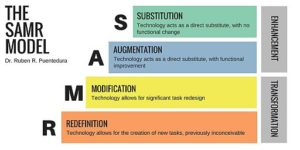10 Selection of Digital Tools
There are literally hundreds of web-based platforms, apps, digital tools and programs available that could be applied in the educational context. Some of them are excellent and some are not. And just because we can use something, doesn’t mean we should. The following tools are effective at evaluating an educational technology for safety, appropriateness and effectiveness.
SAMR
The SAMR model is used to evaluate a digital tool in terms of what the instructor wants to achieve. Each letter of the acronym stands for the degree of integration that the instructor intends the tool to meet.
- Substitution: simply replacing an activity or material with a digital version. There is no functional change. Eg: a reading that has been scanned onto Moodle.
- Augmentation: digital enhancements are incorporated into standard content. Students accomplish the same outcome but with a different interface Eg: a Moodle quiz
- Modification: at this point, the learning activity has been transformed and is integral to the technology. Eg: intentional use of the Zoom chat to facilitate questioning and clarification for students who are otherwise reserved
- Redefinition: learning is fundamentally transformed and the technology enables previously impossible activities to support learning. Eg: virtual reality simulations or a video documentary assignment

SECTIONS
The SECTIONS tool assists instructors in evaluating a specific educational technology for safety, appropriateness, ease and effectiveness. By addressing each step in the acronym, educators should be able to select a digital tool that best meets the intended outcomes, while ensuring safety, and minimizing cost and energy to implement.
- Students:
Who are your students?
What demographics do they come from that could impact their comfort and ability with technology?
Do they have any access barriers or differences in learning preference? - Ease of use:
Does the technology require and orientation to use effectively and when will this occur?
Is the interface user friendly?
Is the technology reliable? - Cost:
Is there a subscription or initial cost?
Who pays for it?
Are there time and energy costs involved to set it up and use it? - Teaching and learning:
Does the tech support the learning outcomes?
Or is it just cool? - Interactivity:
Does this platform facilitate interaction with the content or with other learners? - Organizational issues:
What logistics and supports need to be implemented and maintained in order for the students to use this platform? - Novelty:
Is this new and exciting for the students so as to foster engagement? - Security and Privacy:
Do the students need an account?
Is their information vulnerable?
(Bates, 2015)


Feedback/Errata